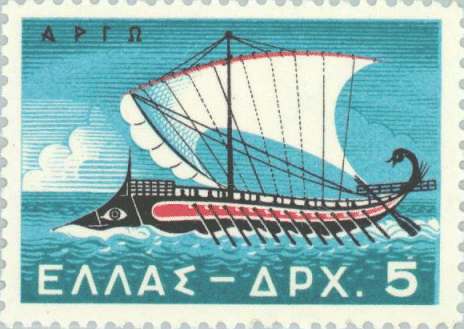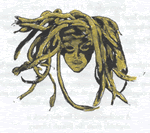|
|
|
|
|
|
|
|
|
|
|
|
|
|
|
|
SNAKEHEAD
|
|
|
|
|
|
|
|
|
|
|
SERIFOS
Serifos today is a quiet island, very dry in
summer, with  one
or two beaches. There are no must-see "Perseus" sites, but
you can find the ancient Xora, & many other Bronze Age remains.
Read all about it in "Serifos, The Unknown Isle", by Joannis
G. Varlas, a terrific book, tho' hard to find except on the island.
The waterfront at Livadi is as I told it: the white-painted tamarisks
are there, and the Yacht Club. Other things I time-shifted, but did
not make up: It's one
or two beaches. There are no must-see "Perseus" sites, but
you can find the ancient Xora, & many other Bronze Age remains.
Read all about it in "Serifos, The Unknown Isle", by Joannis
G. Varlas, a terrific book, tho' hard to find except on the island.
The waterfront at Livadi is as I told it: the white-painted tamarisks
are there, and the Yacht Club. Other things I time-shifted, but did
not make up: It's true that Serifos is "rotten" with the black metal, which
is iron: it's not clear when exploitation began. It's true that Serifos
was one of the first states ever to experiment with democracy, but it
was in the 7th Century BCE, after "Papa Dicty's" time. The
"Town Meeting" style of discussion was inspired by the Melian
dialogue in Thucydides, also after Papa Dicty's time.
true that Serifos is "rotten" with the black metal, which
is iron: it's not clear when exploitation began. It's true that Serifos
was one of the first states ever to experiment with democracy, but it
was in the 7th Century BCE, after "Papa Dicty's" time. The
"Town Meeting" style of discussion was inspired by the Melian
dialogue in Thucydides, also after Papa Dicty's time.
|
|
|
THE GREAT DISASTER

Thera, "Fira", or "Santorini",
the original Atlantis*, was wrecked by a volcanic eruption around
1650 BCE, the biggest physical cataclysm in human history. The date
is uncertain, carbon dating and archaeology don't agree: the record
of what happened afterwards is blurred. Certainly, the disaster dealt
the astonishing civilisation we call "Minoan" a blow from
which it never recovered. Maybe it changed the water tables
of the Aegean, so that peace and plenty could never return. Certainly
there were child-sacrifices, in Knossos on Crete, in the aftermath.
Probably the Mycaeneans took over, a generation or so later,
and there was a renaissance for a while. At Akrotiri,
 on
the southern cape of what remains of Fira, people had time to get
out of the way (you can see the wrecking balls, left behind by the
crews who were clearing up after a major tremor, about twenty years
before). It's here that Marinatos's
excavations of crushed high-rises uncovered the originals of the
wall-paintings in Papa Dicty's taverna. on
the southern cape of what remains of Fira, people had time to get
out of the way (you can see the wrecking balls, left behind by the
crews who were clearing up after a major tremor, about twenty years
before). It's here that Marinatos's
excavations of crushed high-rises uncovered the originals of the
wall-paintings in Papa Dicty's taverna.
*Plato knew nothing about Minoan civilisation,
there had been a Dark Ages in between. He put his city-island in the
Atlantic because he got the story from the Eygptians, and they placed
it "Far, far to the West". Of Eygpt, that is.
|
|
PERSEUS AND ANDROMEDA

Myths are like folksongs, like treasured memories: they gather fantasy
elements, they get mixed up with bigger pictures. Maybe there really
was a Bronze Age Perseus, persecuted by his grandfather, brought up
by a Cycladean fosterfather; who outwitted a tyrant, married a Phonecian
princess called Andromeda (whose Greek name means thinker, or
ruler of men), and eventually returned to the Mainland with her
and his mother, to found Homer's "well built Mycenae, rich in
gold". And from Mycenae, the baton was handed on to Athens,
where Plato wrote about Atlantis.
Or maybe not. All I know for sure is that the constellations associated
with this story take up a sizeable chunk of the night sky over the Med.,
and constellations were vital in ancient times. That's got to
mean something. There are many internet sites (not to mention more ancient
forms of data storage) featuring the story: here's a couple of my favourites.
http://www.greecetravel.com/greekmyths/argos2.htm
http://www.elysiumgates.com/mt_olympus/histpegasus.html

|
|
|
|
 In
Athens Museum you can see the treasures from the Mycenae "princess"
graves. They were buried covered in gold: this gave me the idea for Andromeda's
sacrificial dress. In
Athens Museum you can see the treasures from the Mycenae "princess"
graves. They were buried covered in gold: this gave me the idea for Andromeda's
sacrificial dress. |
|
|
THE YACHT CLUB KIDS

The first summer I spent bumming around the
Aegean, looking for adventure, I was nineteen. I've been back several
times since, same mission, never found the Golden Fleece yet, but
had a lot of fun looking. When I decided to write the Perseus story
it dawned on me that this rite of passage tradition, which now involves
cocktails and beach raves, rather than slaughtering monsters, is thousands
of years old. That's how Jason and the Argonauts came to make their
special guest appearence. What do you mean, it doesn't make sense?
Have another umbrella drink & lets' all go raid Lemnos

|
|
|
 THE
MEDUSA THE
MEDUSA
Reading between the lines, it's quite likely
that Athini's Gorgon Shield came first, and the hero tale about Medusa
getting her head chopped off was a later "rationalisation"
for the female monster being associated with the Goddess of Wisdom.
The Medusa story as a myth of consciousness  just
seems an obvious way to go: snakehead, human brain, the terror of
being self-aware. (Freud thought it was all about castration. Ah,
well. Different strokes.) just
seems an obvious way to go: snakehead, human brain, the terror of
being self-aware. (Freud thought it was all about castration. Ah,
well. Different strokes.)
|
|
|
|
|
|
|
|
|
|
|

THE FLYING MARKS
The Minoans used two main
scripts, one of which (Linear B) has turned out to be a form of Greek;
the other (Linear A) is still a mystery. So is the Phaistos
disk, stamped with 45 hieroglyphic characters, found in the palace
at Knossos in 1908. Alphabetic
writing, came from Phoenicia, and before that from Canaan, first
traced 1800 BCE, it reached the Aegean about the time of Snakehead.
It doesn't quite fit, but you could imagine that what Andromeda invented
was Linear A, the lost Missing Link between Phoenecian scripts, the
Aegean evolutionary line, and ours...
|
|
HORSES, PASTA AND OLIVE TREES
 The island
of Skyros still has a small population of Skyrian wild horses, possibly
the same breed as depicted on the Parthenon: very small, very strong.
(Recalibrate: see Homeric warriors riding on Shetland Ponies) There
may have been horses on Serifos once. Olive trees have been cultivated
in the Mediterranean Basin for about 6,000 years. Venice conquered the
Greek Islands in the thirteenth century CE, which explains all the pasta. The island
of Skyros still has a small population of Skyrian wild horses, possibly
the same breed as depicted on the Parthenon: very small, very strong.
(Recalibrate: see Homeric warriors riding on Shetland Ponies) There
may have been horses on Serifos once. Olive trees have been cultivated
in the Mediterranean Basin for about 6,000 years. Venice conquered the
Greek Islands in the thirteenth century CE, which explains all the pasta.
I made up the opotatos, and the Peruvian connection: although there
are web-thusiasts who believe the Argo sailed to South America.
|
|
|
|
|
|
|
|
|
|
|
|
|
|
|
back to Ann Halam page |
|
|
|
|
|
|
|
|
|
|
|
|











 just
seems an obvious way to go: snakehead, human brain, the terror of
being self-aware. (Freud thought it was all about castration. Ah,
well. Different strokes.)
just
seems an obvious way to go: snakehead, human brain, the terror of
being self-aware. (Freud thought it was all about castration. Ah,
well. Different strokes.)